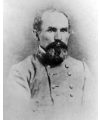This information is based on newspaper accounts and other public information and is presented as accurately as possible. Before you copy and paste this information to your website, please keep in mind that this research took a lot of effort. Appreciate it. Learn from it. But do not plagiarize it. Yes, if you think we might be talking to you, we are.
M
William B. Munford
President
Biography
On June 25, 1855, William B. Munford was elected as president of the Memphis, Clarksville and Louisville Railroad. Munford, a native of Danville, Kentucky, moved to Clarksville in 1839 and ensconced himself in many aspects of the community before his death on July 9, 1859. Within a year of his appointment, he and fellow railroad officials met with their colleagues at the Memphis & Nashville in Paris, Tennessee, to examine a consolidation of their roads. The discussion did not yield a merger.
W. W. Murphy
Conductor
Biography
W.W. Murphy was appointed conductor of the Memphis, Clarksville & Louisville Railroad in March 1861.
“The appointment is an excellent one, and Mr. M. is rapidly growing into favor with the traveling public,” The Clarksville Jeffersonian newspaper in Clarksville, Tennessee, reported on March 27, 1861. “He has worked his way up from the position of brakeman to that of conductor, by strict attention to business, promptness and uniform urbanity, and we are gratified that his good conduct has been appreciated by the Company.”
O
John T. O’Brien
Conductor
Biography
John T. O’Brien (circa 1833-December 7, 1868), a native of Carter County, Tennessee, was a conductor on the Memphis, Clarksville & Louisville Railroad. In early December 1868, John T. O’Brien was riding on top of the northbound freight train when he “was knocked off by coming in contact with the bridge” near Erin, the Clarksville Chronicle reported. Several cars ran over him, killing him. “He was a courteous gentleman and a good conductor,” the newspaper recalled.
P
Q
R
Eugene Riley
Engineer
Biography
Eugene Riley was the engineer on the No. 2 express train on July 28, 1869, when it crashed at Budds Creek near Clarksville, Tennessee.
In the locomotive, steam escaping from the damaged boiler claimed the lives of Riley and the fireman.
Riley, a Bowling Green resident, left behind a wife and a child. The engineer “was regarded as one of the most discreet engineers on the road he served and stood high in the estimation of all who knew him.”
He “was scrupulously circumspect with his locomotive, always complying with the rules by which engine-drivers are governed, especially as to slow running over bridges and trestles.”

